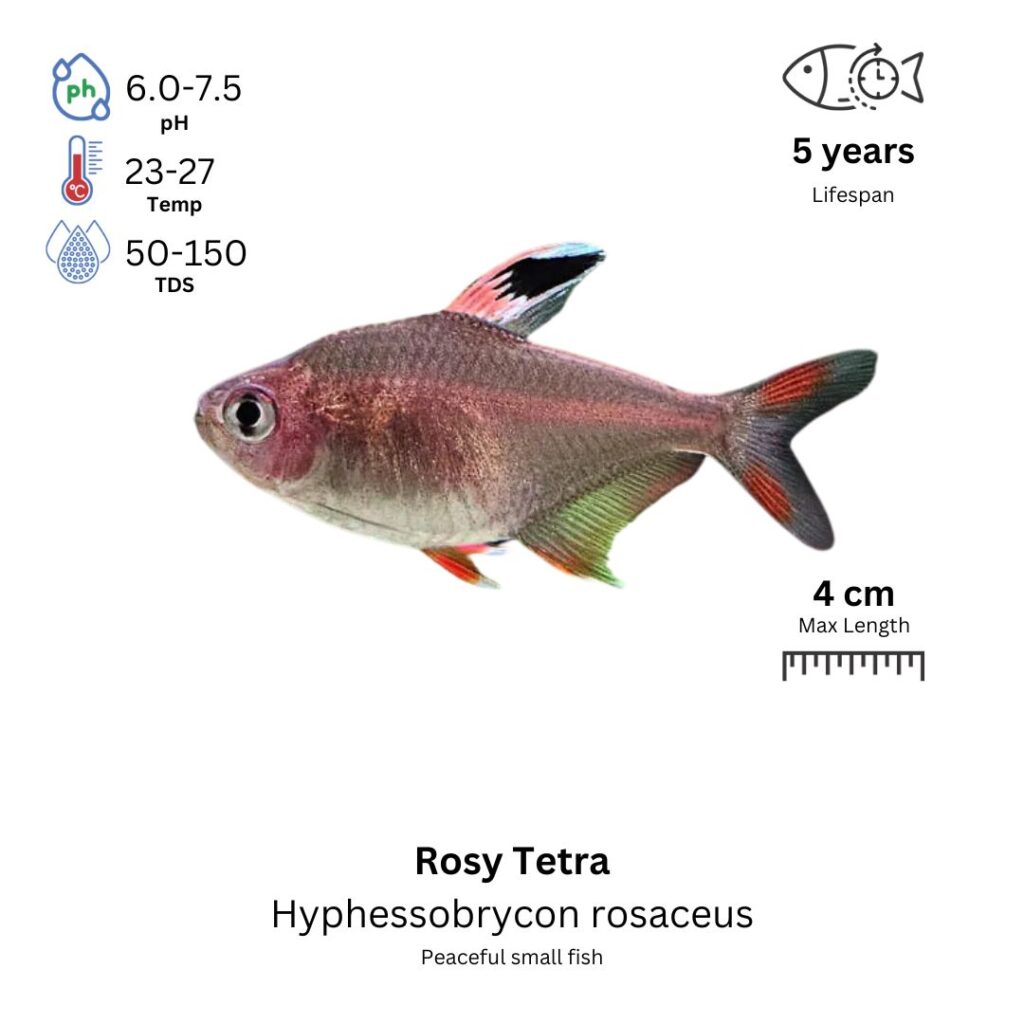Rosy Tetra
Hyphessobrycon rosaceus

Description
The Rosy Tetra is a small and vibrant species of tetra known for its rosy pink to red body coloration, which makes it stand out in an aquarium. Males are typically more colorful, with brighter shades of pink and a more intense red hue along their fins and body. Females are generally paler but still have a soft pink coloration. These fish have a slender, streamlined body and are peaceful, active swimmers, often seen darting through the middle of the tank. Rosy Tetras are social fish that do well in groups, and their colors become more vivid when housed in schools. They are generally calm and peaceful, making them a good addition to community tanks.
Habitat Origin
Native to the slow-moving rivers and streams of South America, particularly in Brazil, Colombia, and Venezuela. They are typically found in areas with dense vegetation and slightly acidic to neutral water, which provides them with hiding spots and grazing areas.
Aquarium
Ideal Number in Aquarium: At least 6 individuals, as they are schooling fish and feel more secure in groups.
Favorite Food

Rosy Tetras are omnivores and will accept a variety of foods, including high-quality flake food, micro pellets, and live or frozen foods such as brine shrimp, daphnia, and bloodworms. They will also consume algae and small plant matter, making them suitable for planted tanks.
Behavior:
Rosy Tetras are peaceful, social fish that do well in schools of at least 6 individuals. They are active swimmers and are often seen swimming through the middle and upper sections of the tank. These fish are generally non-aggressive and do well with other peaceful species, but they can sometimes become nippy if housed with overly aggressive tankmates. Their schooling behavior and vibrant coloration are most noticeable when they are kept in groups, where they feel more secure and interact with each other.
Special Care:
Rosy Tetras thrive in well-planted tanks with plenty of hiding spots, such as plants, driftwood, and rocks. Regular water changes and good filtration are important to maintain stable water conditions, as they are sensitive to poor water quality. Providing a slightly acidic to neutral pH and soft water conditions will help them thrive. These fish prefer a moderate water flow and should not be exposed to extreme changes in water conditions.
Compatibility with Other Fish:
Yes, Rosy Tetras are compatible with other peaceful, small species such as other tetras, rasboras, and small catfish. They should not be kept with larger or more aggressive fish, as they may become stressed or be harassed. Due to their peaceful nature and schooling behavior, they are ideal for community tanks with other non-aggressive species that share similar water requirements.
Breeding Setup
A separate breeding tank is highly recommended for Rosy Tetras to protect eggs and control water parameters. A 10-gallon tank (38 liters) is sufficient for a small breeding group, while a 20-gallon tank (75 liters) provides more space for multiple pairs. Maintain water at pH 6.0–7.5, temperature 24–28°C (75–82°F), and hardness 4–12 dGH. Use a gentle sponge or internal filter to ensure circulation without strong currents. Fine gravel or sand substrate with plants like Java moss or Hornwort helps catch eggs and offer fry shelter. Use moderate lighting on a 12-hour light/dark cycle.
Conditioning for Breeding
Feed Rosy Tetras a nutritious and varied diet to prepare them for breeding. Include high-quality flakes or micro pellets, live/frozen foods like brine shrimp, daphnia, and bloodworms, and vegetable matter like finely chopped spinach or peas. Weekly 20–30% water changes are essential. To trigger spawning, increase the water temperature to around 28°C and do a larger 50% water change, simulating rainy season cues common in tropical habitats.
Spawning Process
Spawning usually occurs in the early morning after water conditions improve. The male courts the female with vivid coloration and close swimming. The female lays 100–200 sticky eggs, which scatter across the substrate and plants. Immediately remove the adults after spawning, as Rosy Tetras may eat their eggs or fry. Ensuring the eggs are undisturbed significantly increases the chances of successful hatching.
Fry Care
Eggs hatch within 24–36 hours, depending on temperature. The fry rely on their yolk sacs for the first few days. Once free-swimming, feed them infusoria or liquid fry food, then gradually introduce baby brine shrimp, microworms, or crushed flakes. Keep water clean and stable (24–28°C). Perform small daily or alternate-day water changes (10–20%), and avoid overfeeding to prevent water quality issues that could harm the delicate fry.
Key Considerations
Rosy Tetras reach breeding age at 6–12 months. Males are slimmer and more colorful, especially during breeding, while females are rounder and less vibrant, particularly when gravid. Avoid sudden shifts in pH, temperature, or hardness, and maintain excellent water quality through regular maintenance. Create a stress-free environment by avoiding aggressive tank mates to support consistent, healthy spawning behavior.
